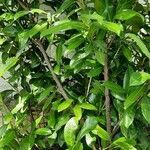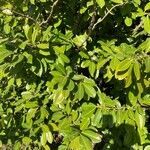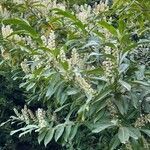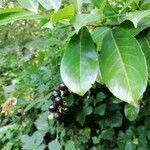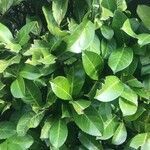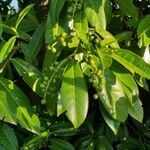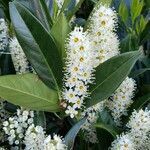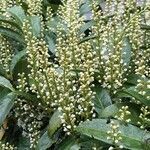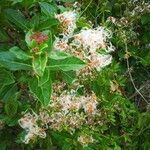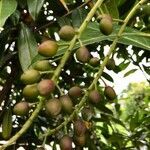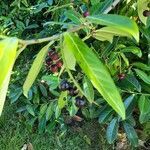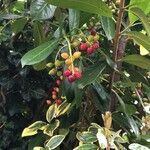Shrubs or trees, sometimes suckering, 20–60(–100) dm, not thorny. Twigs with terminal end buds, glabrous. Leaves persistent; petiole 5–15 mm, glabrous, eglandular; blade elliptic to obovate, 6–18 × 3–7 cm, base cuneate to obtuse, margins remotely serrulate or nearly entire, teeth blunt, glandular, apex abruptly short-acuminate, ?apicula acute?, surfaces glabrous, ?abaxial glandular, glands 1–several, proximal, flat, circular to oval?. Inflorescences 26–32-flowered, racemes; central axes (35–)55–130 mm, ?leafless at bases?. Pedicels 1–5 mm, glabrous. Flowers blooming before leaf emergence; hypanthium cupulate, 3–4 mm, glabrous externally; sepals spreading, triangular, 0.7–1.2 mm, margins usually entire, sometimes with deciduous glands, ?ciliate in spots?, surfaces glabrous or hairy; petals white, obovate or broadly elliptic to suborbiculate, 3–5 mm; ovaries glabrous. Drupes deep purple-red to nearly black, ovoid to conic-ovoid, 13–17 mm, glabrous; mesocarps fleshy to leathery; stones ovoid, not flattened.
An evergreen shrub or tree. It grows 5-10 m high and spreads 6-9 m wide. It is a broad spreading tree. The bark is grey-brown and smooth. The leaves are oblong and 20 cm long by 6 cm wide. The leaves are alternate. They are glossy dark green above and pale green underneath. They are leathery and pointed. They have small wavy teeth. The leaf stalks are thick. The crushed leaves have the smell of almonds. The flowers are small and white. They are 8 mm across. They occur in erect heads 12 cm long. These are in the axils of leaves. The flowers have a scent. The fruit are small cherries which turn from red to black. They are 1.2 cm across.
